
The Different Colours Of Cannabis And What They All Mean
When you first start smoking or growing weed, you might assume it's always green. However, if you get the chance to see more strains, or perhaps grow some yourself, you'll find cannabis plants can develop a range of colours including red, yellow, purple, and even black. Read on to learn what each colour says about a plant's quality and genetics.
When you think of cannabis, we suspect one particular colour comes to mind: green. That makes perfect sense, too, as most weed is green in its healthiest state. But, you may be surprised to learn that’s not the only colour you might see in your weed garden. You can find buds in radiant orange and red hues, if you’d like, or stick with cooler shades like purple, blue, and even black.
Unique colours don’t necessarily make these nugs different from the standard green varieties, aside from their hue. However, they indicate genetic properties that can impact the flavour, potency, and other factors that make up the cannabis experience.
Why Do Cannabis Buds Have Different Colours?

While you’d think a cannabis bud’s colour derives from a single factor, you’ll find that multiple variables may be responsible.
Chemical Structure
A quirk in chemical structure, of course, would be the first reason one might see their bud boasting different colours. As we’ll discuss later, the presence and balance of chemicals like anthocyanins and carotenoids play a major role in what your final harvest will end up looking like, offering every colour of the rainbow (besides green) and more.
Maturity

While this doesn’t affect colour as much as other factors, your plant’s maturity will have a direct impact on the colour of your plant’s pistils, which are the orange hairs you’ll find scattered across mature buds. As your plant gets closer to harvest time, that shade of orange gets increasingly vibrant, and you might find red, pink, and brown hues popping up on top of that.
Deficiencies
Besides those factors, nutrient or water deficiencies would be the last (and least fortunate) reason you’d see colours besides green on your cannabis. If there isn’t enough nitrogen in their daily intake, for example, you might see the leaves shift to a yellow hue. Not giving your plants enough phosphorus can lead to their leaves signalling issues by turning abnormally red.
As we explained before, though, those colours are not an inherent sign of issues. However, if you know your strain doesn’t normally feature them, it’s worth checking your nutrient solution.
What Cannabis Colours Are There?
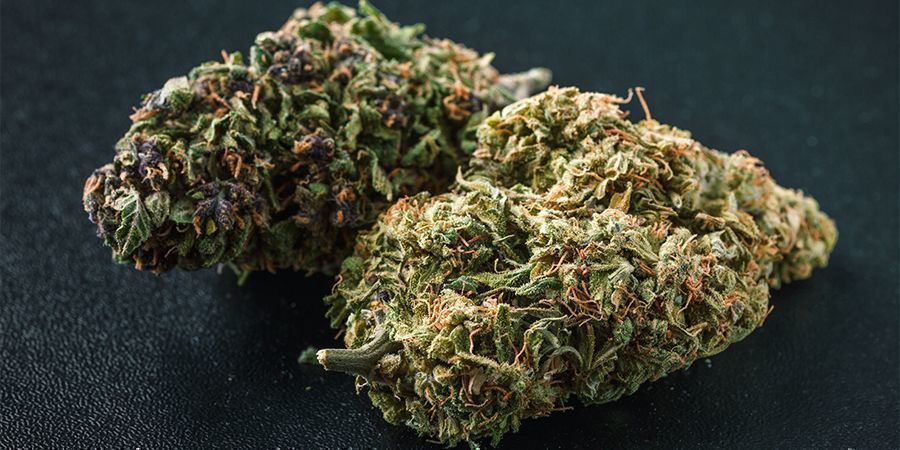
We’ve briefly mentioned some of what you might see, but let’s take a deeper look into exactly which cannabis bud colours are out there. In that process, we’ll also consider what exactly leads to weed taking on those pigments.
Green (Chlorophyll)
As with most other plants, the chlorophyll in cannabis, which captures sunlight to help plants grow via photosynthesis, also envelopes them in a bright green colour. Given its central nature to the survival of cannabis plants, it only makes sense that chlorophyll makes up around 70% of the pigments you’ll find in cannabis plants.
Yellow/Orange (Carotenoids)
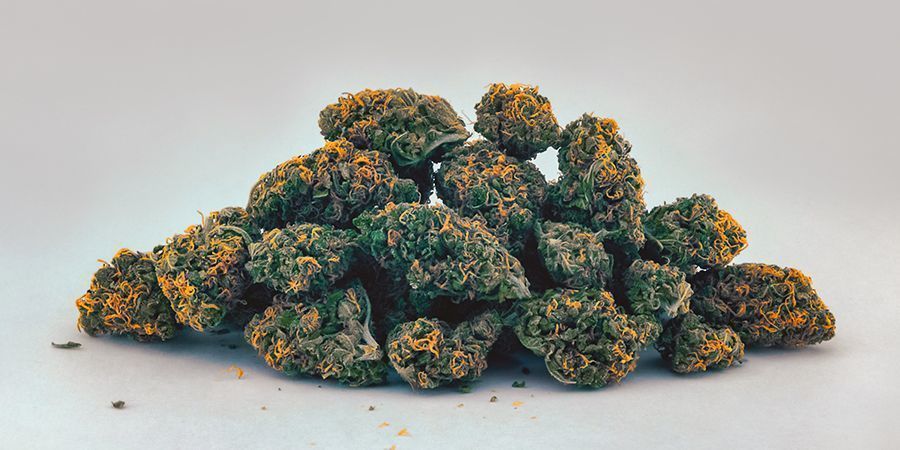
Now, if you want your buds to blossom with notable shades of orange and yellow, you could breed strains with a similar carotenoid balance together. Carotenoids help chlorophyll gather energy from light for photosynthesis, although they usually get masked by the presence of those primary light-gathering pigments. Once they start to degrade around harvest time, however, they begin to pop out a bit more and show off.
Red/Pink (Carotenoids and Anthocyanins)
Along with carotenoids, you may find red and/or pink hues appear on your cannabis due to the presence of anthocyanins. For those unfamiliar, these are a specific type of flavonoid, which are phytochemicals that are specifically in charge of giving plants their colours.
Anthocyanins create certain colours in combination with carotenoids, the most common of which are red and pink. That being said, they can produce a variety of other colours depending on the pH level and various other factors. In fact, many of the most popular shades of weed wouldn’t be possible without anthocyanins.
Purple/Blue (Anthocyanins)
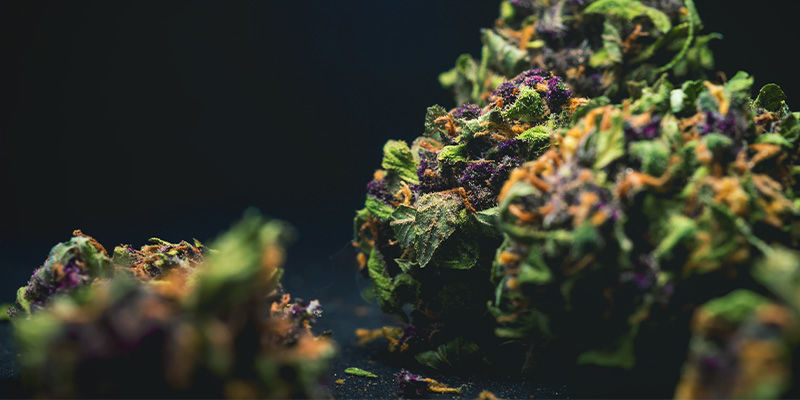
Speaking of those popular shades, anthocyanins are also the primary reason why certain strains are able to take on a purple or blue hue.
Specifically, as anthocyanins build up in greater amounts within the plant, the pigment of your nugs will shift toward darker shades of those colours. Decreasing the temperature can help you obtain your optimal shade, as this will activate the antifreeze properties of those compounds. That being said, you’ll still need an anthocyanin buildup from the start to bring it about. You would need to achieve a more neutral pH as well.
Black
So, purple and blue may seem achievable, but what about black cannabis? Well, a plant appearing black just means that there are not only many anthocyanins present, but that they’re also reacting to particular changes in their environment.
To start, these compounds are activated when temperatures drop and they have to help prevent the water in cannabis from freezing. The second piece of the puzzle, then, is the pH of your plant’s soil.
Cannabis normally likes a slightly acidic medium. Tip it in a more acidic direction, and you’ll see anthocyanins make the plant a bright red. Keep it towards the neutral end, though, and you’ll end up with increasingly darker shades. More specifically, you’ll want your plants to sit somewhere in the 5.8–6.8 range for ideal results.
How To Change the Colour of Cannabis Buds
Now that you have a better idea of what colours you may see pop up on buds, you might want a better idea of how to manipulate them to your liking. Sure, some people bring up some risky methods online, but there are simple and safe ways to go about it.
Genetics
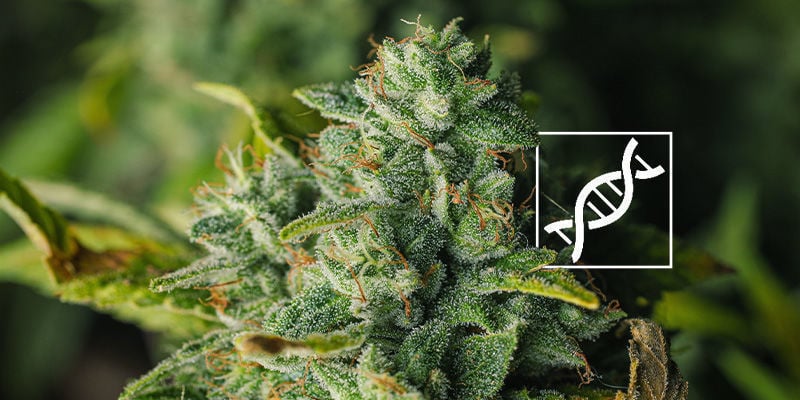
To start, as we mentioned earlier in this article, there are strains with particular genes that give them the vibrant, varied colours you see on their nugs. You can either grow them as is for predictable yet exciting results, or breed these strains together for entirely new colour palettes and experiences.
-
Kalini Asia
If you’re craving some deep purple buds, for instance, Kalini Asia is one of the best places to start. This hybrid of Black Domina and Purple Kush boasts 22% THC and 70% indica genetics, offering a deeply soothing and munchie-inducing high. It’s delicious, too, offering classic Kush flavours with a kiss of lemon.
-
Blueberry
Blueberry by Zamnesia is an all-around pleasing strain. Its robust growth and high yields will favour both rookie and advanced growers, while its rich berry aroma will delight even the fussiest weed enthusiasts. True to DJ Short's original Blueberry, Zamnesia's recreation boasts a happy, relaxing high that's both physically and mentally soothing. And then, of course, there is her light blue and purple foliage to consider; quite a pleasing sight as the flowering period comes to a close.
-
Auto Purple Couskush
Lastly, Auto Purple Couskush shines bright with displays of purple, green, and orange in vibrant unity. This Purple Kush x ruderalis descendant hits decently hard too, with 20% THC and hybrid genetics offering a high that eases tension and makes you feel alive. It’s a sweet and fruity delight, and grows in just a couple months.
Environmental Factors
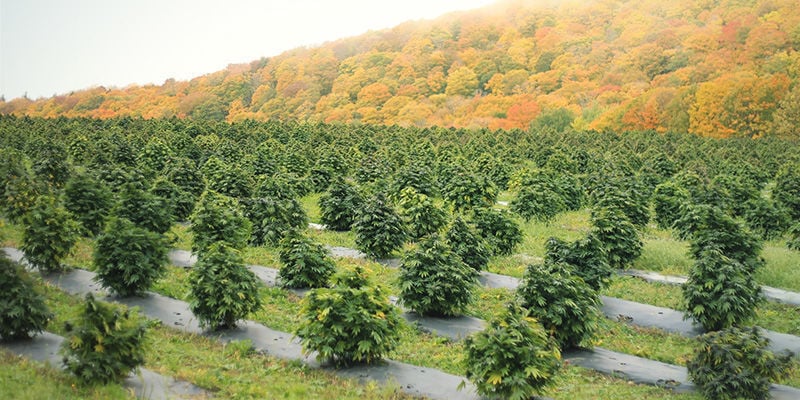
No matter how you shake it, a plant having the right genetics is essential to achieving your desired colours. That being said, fully expressing these colours comes down to how well you can balance out key environmental factors.
-
Nutrients
Now, some websites will claim that you should give your plants an excess or deficiency of a certain nutrient to shift their colour.
While it does make the plant change colour, it does not do so in a healthy way. The leaves may look prettier than standard, but an improperly nourished plant won’t taste nearly as good, hit nearly as hard, or even make it to harvest time in the first place.
To be safe, just give your plants the ideal amount of nutrients, as the right plant will flourish with colour when given the best possible circumstances.
-
Temperature
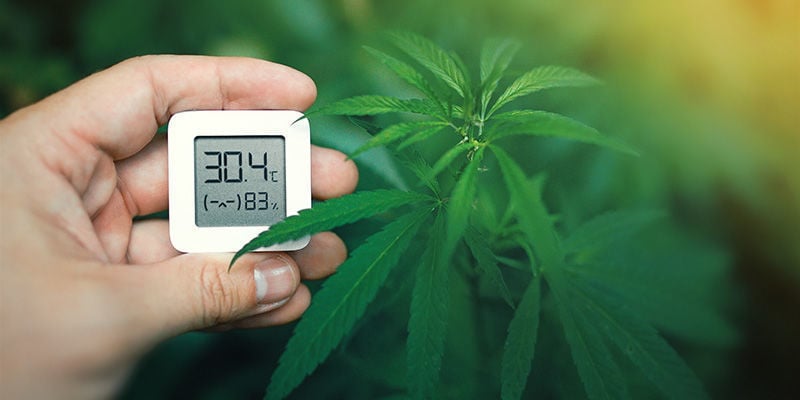
As mentioned, the anthocyanins in cannabis activate upon noticing a temperature drop. They’re prompted to carry out an antifreeze-like function that helps to retain water in the plant, and this process just so happens to turn weed plants purple. In fact, the more anthocyanins present, the darker your plant can potentially get.
This doesn’t mean you should subject your plant to excessively cold temperatures, though. Make sure it’s still warm enough for the plant to thrive, and carry out any temperature decrease slowly and carefully. After all, little adjustments can change a plant’s growing process dramatically, and you don’t want to risk causing any irreversible issues.
-
pH Level
If you want to make sure you end up with some gorgeous purple buds, pH level is the final factor you want to account for. Just as was discussed a few sections back, keep the pH of your soil somewhere between 5.8 and 6.8 to achieve the ideal hue, as cannabis plants still need slightly acidic soil to thrive.
Does Colour Affect the Potency of Cannabis Buds?
So, getting to the bottom line, is there a connection between the colour of cannabis buds and their potency? Well, it depends on the genetics of the strain and how that colour is achieved.
If the colour shift is due to improper care or nutrient imbalances, you’ll find the resulting buds don’t hit nearly as hard as they should. However, if you treat your plant ideally, and it’s already predisposed to expressing different shades, there won’t be a connection between colour and potency. Just make sure you pick the right genetics, take good care of your plants, and enjoy growing!





 United States
United States












